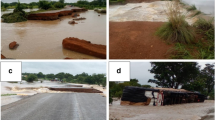Abstract
GIS-based landslide hazard zonation has been carried out for a tectonically active region of the Himalayas, which is under pressure for rapid economic development. Thematic layers of slope, fault, geology, land use, flow accumulation, drainage and roads were prepared based on topographic maps, satellite imagery, published geological maps and ground truth. Five classes of landslide hazard were identified; 24% of the total area falls into the Very high or High hazard zones where 54% of the observed landslides were recorded.
Résumé
Un zonage de l’aléa glissements de terrain, sur la base d’un système d’information géographique, a été réalisé dans une région tectoniquement active de l’Himalaya, en cours de rapide développement économique. Des couches thématiques relatives aux pentes des terrains, aux zones faillées, aux contextes géologiques, à l’occupation des sols, aux zones de convergence des écoulements, aux types de drainage naturel et aux infrastructures routières ont été préparées à partir de cartes topographiques, d’images satellitaires, de cartes géologiques et de contrôles terrain. Cinq classes d’aléa glissement de terrain ont été identifiées: 24% de la surface totale cartographiée est constitué de zones de très fort ou fort aléa où se trouvent répertoriés 54% des glissements observés.




Similar content being viewed by others
References
Aleotti P, Chowdhury R (1999) Landslide hazard assessment: summary review and new perspectives. Bull Eng Geol Environ 58:21–44
Anbalagan R (1992) Landslide hazard evaluation and zonation mapping in mountainous terrain. Eng Geol 32(4):269–278
Bonham-Carter GF (1994) Geographic information systems for geoscientists: modelling with GIS. Pergamon/Elsevier, Langford Lane, Kidlington
Bonham-Carter GF, Agterberg FP, Wright DF (1990) Weights of evidence modeling: a new approach to mapping mineral potential
Carrara A, Cardinali M, Detti R, Guzzetti F, Pasqui V, Reichenbach P (1991) GIS techniques and statistical models in evaluating landslide hazard. Earth Surf Process Landf 16:427–445
Dai FC, Lee CF, Ngai Y (2002) Landslide risk assessment and management: an overview. Eng Geol 64:65–87
Kumar R, Pande IC (1972) Deformation of rocks of Simla Hills. Geol Rundsch 61(2):430–441
Larsen MC, Parks JE (1997) How wide is a road? The association of roads and mass movements in a forested montane environment. Earth Surf Process Landf 22:835–848
Medlicott HB (1864) On the geological structure and relation of the southern portion of Himalayan Ranges between the river Ganges and Ravee. Mem Geol Surv India 3:1–207
Nakata T (1972) Geomorphic history and crustal movement of the foothills of the Himalaya, 7th series. Report of Tohoku University Japan (Geography), 2
Narula PL, Shome SK, Nandy DR (1989) Neotectonic activity in the Himalayas (special publication). Geol Surv India 26:119–141
Neaupane KM, Piantanakulchai M (2006) Analytical network process model for landslide hazard zonation. Eng Geol 85:281–294
Philip G, Virdi NS (2007) Active faults and neotectonic activity in the Pinjaur Dun, Northwestern Frontal Himalaya. Curr Sci 92(4):532–542
Rupke J (1974) Stratigraphic and structural evolution of the Kumaun Lesser Himalaya. Sed Geol 11:81–265
Soeters RS, Van Westen CJ (1996) Slope instability recognition, analysis, and zonation (Special Report 247). In: Turner AK, Schuster RL (eds) Landslides, investigation and mitigation. Transportation Research Board, National Research Council, National Academy Press, Washington, DC, Chap 8, pp 129–173
Srikantia SV, Bhargava ON (1976) Tectonic evolution of the Himachal Himalaya. Misc. Publication. Geological Survey of India 34(1):217–236
Valdiya KS (1993) Uplift and geomorphic rejuvenation of Himalaya in the Quaternary period. Curr Sci 64(11&12):873–885
Van Weston CJ (1993) Training package for geographic information systems in slope instability zonation, Part 1. ITC publication 15, Enchede, The Netherlands, p 245
Varnes DJ (1984) Landslide hazard zonation. A review of principles and practice. UNESCO, France
Acknowledgments
We are thankful to Dr. V.K. Dadhwal Dean, IIRS, Dehradun for allowing us to carry out some analysis at the institute. MS would also like to acknowledge University Grants Commission for providing her a junior research fellowship. Sincere thanks are due to Department of Geology, Panjab University for providing the facilities and help in carrying out this study.
Author information
Authors and Affiliations
Corresponding author
Rights and permissions
About this article
Cite this article
Sharma, M., Kumar, R. GIS-based landslide hazard zonation: a case study from the Parwanoo area, Lesser and Outer Himalaya, H.P., India. Bull Eng Geol Environ 67, 129–137 (2008). https://doi.org/10.1007/s10064-007-0113-2
Received:
Accepted:
Published:
Issue Date:
DOI: https://doi.org/10.1007/s10064-007-0113-2




